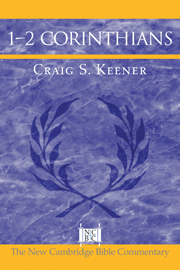Book contents
- Frontmatter
- Contents
- List of Abbreviations
- I INTRODUCTION TO CORINTH AND 1 CORINTHIANS
- II SUGGESTED READING FOR CORINTH AND 1 CORINTHIANS
- III COMMENTARY ON 1 CORINTHIANS
- IV INTRODUCTION TO 2 CORINTHIANS
- V SUGGESTED READING FOR 2 CORINTHIANS
- VI COMMENTARY ON 2 CORINTHIANS
- Author Index
- Scripture and Apocrypha Index
- Index of Extrabiblical Jewish and Christian Sources
- Other Greco-Roman Sources
- Subject Index
III - COMMENTARY ON 1 CORINTHIANS
Published online by Cambridge University Press: 05 June 2012
- Frontmatter
- Contents
- List of Abbreviations
- I INTRODUCTION TO CORINTH AND 1 CORINTHIANS
- II SUGGESTED READING FOR CORINTH AND 1 CORINTHIANS
- III COMMENTARY ON 1 CORINTHIANS
- IV INTRODUCTION TO 2 CORINTHIANS
- V SUGGESTED READING FOR 2 CORINTHIANS
- VI COMMENTARY ON 2 CORINTHIANS
- Author Index
- Scripture and Apocrypha Index
- Index of Extrabiblical Jewish and Christian Sources
- Other Greco-Roman Sources
- Subject Index
Summary
PAUL'S GREETING
1:1: Paul, called to be an apostle of Christ Jesus by the will of God, and our brother Sosthenes,
1:2: To the church of God that is in Corinth, to those who are sanctified in Christ Jesus, called to be saints, together with all those who in every place call on the name of our Lord Jesus Christ, both their Lord and ours:
1:3: Grace to you and peace from God our Father and the Lord Jesus Christ.
Paul's letter introduction follows conventional forms for letter openings (especially for Jews writing in Greek). Conventional elements of letter openings could be expanded as needed, and Paul's specific departures from such convention reveal distinctive points about his apostolic understanding of God, Christ, and what the church is meant to be.
Letters always began by naming the sender. Paul introduces himself as an “apostle,” a legate of Christ authorized to act as his representative (1:1). Although his ministry is not yet in much dispute (contrast 2 Cor 2:14–7:3; esp. 11:5; 12:11–12), he has reason to emphasize his apostolic authority (1 Cor 9:1–2, 5; 12:28–29); for him, however, this calling is a mark of suffering (4:9) and undeserved favor (15:7, 9).
Composite authorship claims in Paul may function differently in different texts; although the letter often uses “we” to include Paul's fellow-workers (e.g., 4:9–13), Paul does not limit it to Sosthenes (cf. 4:6; 9:4–5). Sosthenes may have been Paul's rhetorically proficient scribe (cf. Rom 16:22), helping with multiple rhetorical devices that counter criticism of his speech (see discussion later).
- Type
- Chapter
- Information
- 1-2 Corinthians , pp. 20 - 142Publisher: Cambridge University PressPrint publication year: 2005



